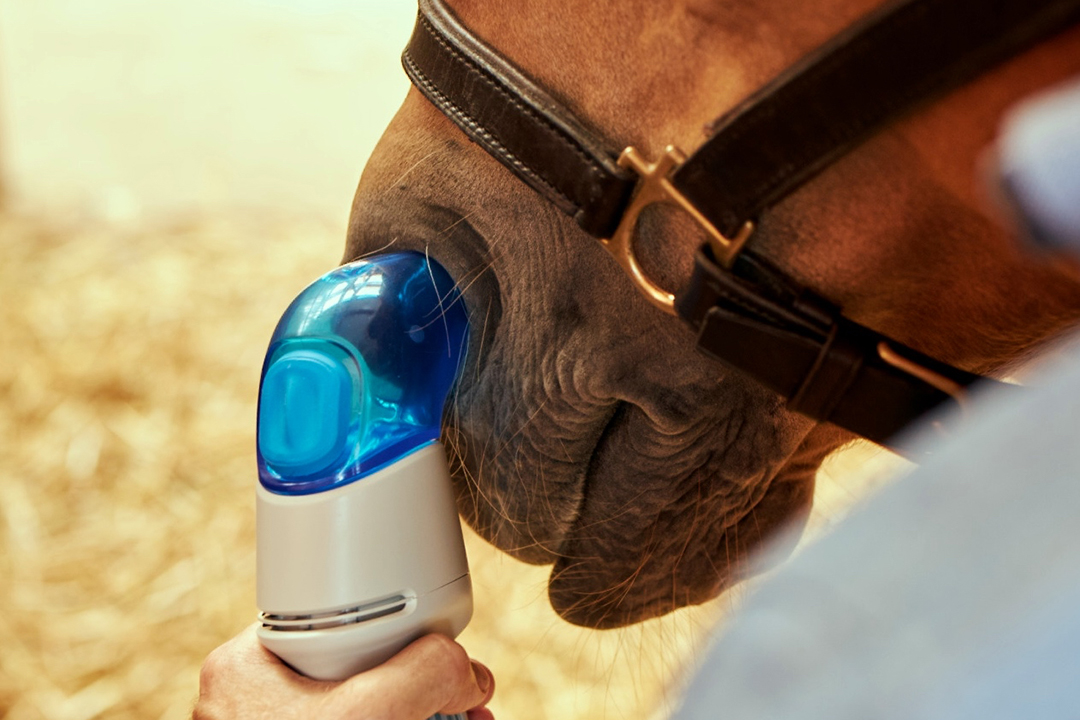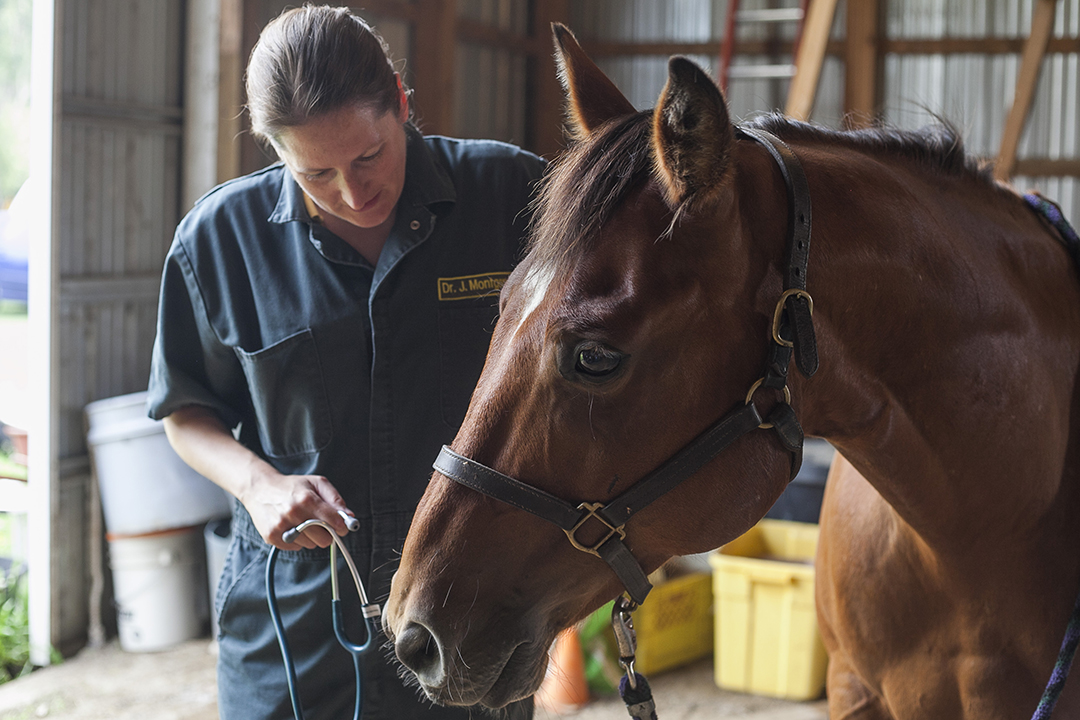
New therapy helps horses breathe easier
Canadians have access to the first licensed and approved inhalation therapy specifically developed to help horses with severe equine asthma without causing unwanted side effects.
By Myrna MacDonaldDeveloped by Boehringer Ingelheim Animal Health (BI), the Aservo® EquiHaler® is an inhalation therapy available through veterinarians. It’s used to treat equine asthma, formerly known as recurrent airway obstruction (RAO) or heaves.
Like humans, environmental triggers such as inhalable organic and inorganic dust, mould, bacteria and pollen cause asthma to develop in horses. Feeding dry hay – especially low-quality feed — is the most common source of these particles. For some horses, the disease becomes worse when they’re kept outdoors in the summer, likely triggered by pollen.
Mild cases of equine asthma can cause coughing, nasal discharge and reduced performance. Horses with severe asthma suffer from chronic cough, nasal discharge, excessive effort when breathing, poor recovery after exercise or exercise intolerance, and weight loss.
The product uses ciclesonide, a corticosteroid, with the Soft Mist Inhaler™ — a unique inhalant delivery system that BI initially developed for use in human respiratory therapies.
“It ticks all of the boxes: it’s the only licensed, inhaled product available for equine asthma on the market, and it’s very efficacious with a simple 10-day protocol,” says Dr. Doug Myers, BI’s western Canadian technical services veterinarian.
Once prescribed, an owner can give the precise dose by inserting the device into the horse’s left nostril and then delivering a series of “puffs” — eight puffs twice a day for five days, followed by 12 puffs once a day for another five days.
Defined as a “prodrug,” ciclesonide is a biologically inactive compound. Once a horse inhales the drug, it metabolizes and transforms into a much more potent corticosteroid that helps to treat inflammation directly in the patient’s lungs.
“The Soft Mist Inhaler™ inhaler technology delivers the drug through the horse’s nostril so it avoids the issue of [the drug] being accidentally swallowed. It’s easy to inhale as the mist goes in at a low velocity, naturally following the inhaled air, and the particle size is very small — less than five microns — so the drug gets directly into the horse’s lungs,” says Myers.
He adds that after some initial training, most horses in clinical trials accepted the inhaler without issues.

The device is meant for a 10-day treatment period and can’t be reused since it’s licensed as a pharmaceutical product. However, the product is recyclable — 50 per cent of the inhaler’s body is made out of recycled materials. The inhalant technology also doesn’t require the use of a propellant (a substance used to move a drug), which significantly reduces its carbon footprint in comparison to meter dose inhalers.
The new therapy was approved for European markets in February 2020. Two months later, it became the first product to receive dual approval by the U.S. Food and Drug Administration and Canada’s Veterinary Drug Directorate. While the therapy has been available in the U.S. since last fall, it was just launched in Canada in January 2021.
One Canadian veterinarian who has been waiting to use the product is Dr. Julia Montgomery, a large animal internal medicine specialist and researcher at the Western College of Veterinary Medicine (WCVM). She reviewed a prototype in 2019 when she and other equine asthma specialists attended a BI-hosted advisory meeting in Montréal, Que.
Montgomery is excited about the new therapy for two key reasons. First, it doesn’t appear to cause systemic cortisol suppression, which can lead to laminitis — a serious side effect of some corticosteroids. This is good news for horses that already have a higher risk of developing laminitis because of other conditions including equine metabolic syndrome and pituitary pars intermedia dysfunction.
“The second reason is that they’ve (BI) done really good field trials with a large number of horses, both in Europe and North America,” says Montgomery, an associate professor in the WCVM’s Department of Large Animal Clinical Sciences. “They’ve done a good job on efficacy and safety.”
Myers says more than 600 horses participated in clinical trials including healthy horses (as controls) and horses diagnosed with severe asthma. The trials demonstrated that the 10-day treatment is effective in reducing clinical signs of the disease.
In the North American study, after the 10-day treatment was completed, researchers selected 100 of the enrolled horses with severe asthma to receive the inhalant therapy for an additional 90 days. No negative side effects were reported even after receiving treatment for 100 days.
As part of the testing process, researchers also investigated withdrawal times for the drug when it’s used to treat performance horses competing in regulated sports such as racing, show jumping, dressage and endurance riding. Those results are now under international review.
While this new therapy is effective, both Myers and Montgomery stress that environmental management is the first step in treating equine asthma. Since the inhalation of airborne dust directly leads to airway inflammation, a critical part of managing this disease is decreasing the amount of dust and allergens in the horse’s environment.
“Asthma is a chronic disease, so one of the really important messages to get across to horse owners is that none of this will work if you don’t also change the horse’s environment,” says Montgomery. “Essentially these steroids are to treat flare-ups of asthma — it’s to get them past the acute phase of the disease, and some may need another treatment.”
In severe cases, Myers says some horses may also need bronchodilation that relaxes the lungs and opens up the airways, “but that’s only if they need it. The two things you have to do first is environmental modification and corticosteroid therapy.”
For both Myers and Montgomery, another exciting aspect of the product’s development is that much of the research was done in Canada through Dr. Jean-Pierre Lavoie and his research team at the Université de Montréal.
Lavoie is renowned for his research work in equine asthma and maintains a resident herd of asthmatic research horses as part of his research program. Lavoie’s team conducted an initial comparison of two corticosteroids, as well as subsequent studies to determine dosing, duration of treatment, and the mode of delivery.
“The cool thing that they’ve shown with their data is that every horse gets exactly the same treatment regimen, which makes the product a lot more user friendly,” says Montgomery.
For more information, visit bicanadaequine.ca.
